How to Help Clients Training for a Bodybuilding Competition (Free Guide)
Learning how to train clients for a bodybuilding competition can greatly enrich your personal training services. But, it’s key that you have the proper tools and knowledge to effectively guide these clients. Utilizing specific features of personal training software can prove essential in this process. Learn how to guide clients training for a bodybuilding competition and all the best personal trainer online tools you’ll need in this detailed guide.
- Assisting clients in bodybuilding competition training requires a meticulous approach that combines strength training, cardio for fat loss, and a nutrient-specific dietary plan to enhance muscle mass.
- Most bodybuilding competition clients will benefit from a rigorous workout schedule and a carefully structured diet plan aimed at optimizing muscle growth and minimizing body fat.
- The use of workout and assessment software can help monitor progress, manage dietary needs, and adjust workouts, ensuring your clients’ journey towards their competition goals is both efficient and successful.
Guiding clients towards their bodybuilding competition goals can offer personal trainers a fulfilling avenue to significantly impact their clients’ fitness journeys.
To assist clients training for a bodybuilding competition effectively, it’s essential to have the right tools for tracking progress, managing nutrition, and tailoring workouts; that’s where the top personal training software shines. By leveraging the features offered by the best online personal training software, you can guide clients in their bodybuilding competition journey in a way that is efficient, personalized, and rewarding for them.

Experience the leading personal training software from Exercise.com by booking a demo today!
The Importance of Goal Setting in Bodybuilding Competitions
Achieving success in a bodybuilding competition requires not only dedication and hard work, but also proper guidance and support. As a trainer or coach, it is crucial to understand the unique challenges that bodybuilding competitors face and be equipped with the knowledge and strategies to help them reach their goals. In this comprehensive guide, we will explore the various aspects of training for a bodybuilding competition and provide you with valuable insights and tips to assist your clients on their journey towards the stage.
Setting clear and specific goals is the foundation of any successful endeavor, and bodybuilding competitions are no exception. Helping your clients establish realistic and achievable short-term and long-term goals is essential to keep them motivated and focused throughout their training. Encourage them to set targets for muscle mass gain, body fat percentage reduction, and specific posing routine improvements. By breaking down the overall goal into smaller milestones, your clients will be able to track their progress and stay committed to the process.
Furthermore, goal setting in bodybuilding competitions not only helps your clients stay motivated, but it also provides them with a sense of direction and purpose. When individuals have a clear vision of what they want to achieve, they are more likely to stay committed to their training regimen and make the necessary sacrifices to reach their goals.
Read More: Best Bodybuilding Gym Software
Understanding the Different Bodybuilding Competition Categories
Before diving into the training program, it is important to have a thorough understanding of the different bodybuilding competition categories. Each category has specific criteria regarding muscular development, symmetry, and body proportions. Whether your clients aspire to compete in the Men’s Bodybuilding, Women’s Fitness, or Classic Physique category, understanding the judging criteria and physique requirements will help you tailor their training and posing routines accordingly.
Furthermore, it is essential to be aware of the different posing requirements for each category. Men’s Bodybuilding, for example, typically involves mandatory poses such as the front double biceps, side chest, and rear lat spread. On the other hand, Women’s Fitness may require more dynamic and acrobatic poses, showcasing flexibility and strength. Classic Physique, inspired by the golden era of bodybuilding, emphasizes classic poses that highlight the overall aesthetic and symmetry of the physique.
Creating a Customized Training Program for Bodybuilding Competitors
A well-designed training program is crucial for helping your clients build strength, muscle mass, and impeccable physique. Tailor each program to your clients’ individual needs, taking into consideration their current fitness level, training experience, and competition timeline. Incorporate a combination of resistance training, cardiovascular exercise, and flexibility work to address all aspects of their physique and performance. Gradually increase the intensity and volume of their workouts to facilitate muscle growth and enhance their overall conditioning.
When creating a customized training program for bodybuilding competitors, it is important to also consider their nutritional needs. A balanced diet that includes adequate protein, carbohydrates, and healthy fats is essential for supporting muscle growth and recovery. Encourage your clients to consume nutrient-dense foods and stay properly hydrated to optimize their performance and achieve their desired physique.
In addition to physical training and nutrition, mental preparation is also key for bodybuilding competitors. Help your clients develop a positive mindset and teach them techniques for managing stress and staying focused during competitions. Incorporate visualization exercises and goal-setting strategies into their training program to enhance their mental resilience and confidence on stage.
Nutritional Strategies to Fuel Bodybuilders for Competition
Proper nutrition is the key to optimizing performance and achieving the desired physique for the competition stage. Educate your clients on the importance of macronutrients – protein, carbohydrates, and fats – for muscle growth, energy production, and overall recovery. Help them calculate their daily caloric needs, and guide them in creating a well-balanced meal plan that supports their training goals. Emphasize the significance of nutrient timing, encourage them to prioritize whole, unprocessed foods, and teach them to listen to their body’s hunger and satiety cues.
In addition to macronutrients, bodybuilders should also pay attention to their micronutrient intake. Micronutrients, such as vitamins and minerals, play a crucial role in supporting overall health and optimizing performance. Encourage your clients to consume a variety of fruits, vegetables, and whole grains to ensure they are getting a wide range of micronutrients.
Furthermore, hydration is often overlooked but is essential for bodybuilders. Adequate water intake is necessary for maintaining optimal muscle function, regulating body temperature, and supporting digestion. Advise your clients to drink water throughout the day and to monitor their urine color as a general indicator of hydration status.
Maximizing Muscle Growth through Effective Weightlifting Techniques
Weightlifting is the cornerstone of any bodybuilding training program. To help your clients achieve maximum muscle growth, teach them proper lifting techniques and emphasize the importance of progressively overloading their muscles. Encourage them to focus on compound exercises such as squats, deadlifts, bench presses, and overhead presses to engage multiple muscle groups simultaneously. Emphasize the mind-muscle connection and guide them through each repetition, ensuring proper form and execution.
The Role of Cardiovascular Exercise in Bodybuilding Competition Training
Although bodybuilding is primarily focused on muscle development, cardiovascular exercise plays a crucial role in optimizing overall conditioning and fat loss. Help your clients understand the different types of cardiovascular exercise – steady-state cardio and high-intensity interval training (HIIT) – and the benefits of each. Incorporate cardio sessions into their training program to improve cardiovascular endurance, promote fat burning, and enhance recovery between weightlifting sessions.
Building Endurance and Stamina for Posing Routines and Stage Presence
Presentation is a vital aspect of bodybuilding competitions, and building endurance and stamina is essential for showcasing a well-conditioned physique throughout the posing routine. Include specific exercises and training techniques to improve your clients’ posing endurance, such as isometric holds, posing practice sessions, and cardio drills that mimic the demands of the routine. Encourage them to practice posing regularly, refining their transitions, and ensuring they can maintain muscle tension and stage presence throughout the routine.
Balancing Rest and Recovery for Optimal Performance in Competitions
While training intensity and consistency are crucial for progress, it is equally important to emphasize the significance of rest and recovery. Teach your clients about the importance of sleep, nutrition, and active recovery techniques such as foam rolling and stretching. Encourage them to listen to their bodies, prioritize rest days, and create a well-structured training schedule that allows for adequate recovery. Emphasize that proper recovery is essential for muscle repair, injury prevention, and long-term progress.
Mental Preparation: Developing a Winning Mindset for Bodybuilding Competitions
Competing in bodybuilding requires not only physical strength but also mental resilience and confidence. Help your clients develop a winning mindset by teaching them techniques such as visualization, positive self-talk, and goal setting. Encourage them to embrace challenges and setbacks as opportunities for growth, and guide them in managing pre-competition nerves and anxiety. By developing mental toughness and a positive outlook, your clients will be better equipped to handle the pressures of the competition stage.
Supplementing for Success: The Best Supplements for Bodybuilders
While a well-balanced diet should provide most of the necessary nutrients, certain supplements can support your clients’ training and enhance their performance. Educate them about popular supplements such as protein powders, creatine, branched-chain amino acids (BCAAs), and pre-workouts. Help them understand the benefits, dosage recommendations, and potential side effects of each supplement. Always remind your clients that supplements are not a substitute for a proper diet and training program, but rather a complementary addition.
Fine-tuning Your Diet: Preparing for Peak Condition on Competition Day
As the competition day approaches, it is crucial to fine-tune your client’s diet to achieve peak condition. Guide them through the process of water manipulation and sodium manipulation to enhance muscle definition and minimize water retention. Gradually adjust their macronutrient ratios to elicit fat loss while preserving muscle mass. Teach them the importance of proper carbohydrate loading to fuel their workouts and ensure optimal glycogen stores. Moreover, be available to offer support and guidance during the challenging final weeks leading up to the competition.
Perfecting Posing: Tips and Techniques to Showcase Your Physique
Posing is a fundamental aspect of bodybuilding competitions, as it allows competitors to highlight their hard-earned physique and command the stage. Provide your clients with expert guidance on posing techniques specific to their competition category, such as front poses, back poses, and transitions. Offer feedback and constructive criticism during posing practice sessions, helping them become more confident and refined in their movements. Use video recordings to analyze their posing routine and identify areas for improvement.
Overcoming Plateaus: Strategies to Keep Making Progress in Training
Progress is not always linear, and clients may encounter plateaus in their training journey. Empower them with strategies to overcome these challenges and continuously make progress. Implement various training techniques like drop sets, supersets, and circuit training to promote muscle growth and break through plateaus. Encourage your clients to set new goals, experiment with different exercise variations, and seek guidance and support from their fellow competitors or online fitness communities.
The Importance of Sleep in Bodybuilding Competition Preparation
Amidst the hustle and bustle of training, nutrition, and competition preparation, sleep often gets overlooked. Educate your clients on the crucial role of sleep in muscle recovery, hormone regulation, and overall well-being. Stress the importance of establishing a consistent sleep schedule, creating a sleep-friendly environment, and adopting relaxation techniques before bed. By prioritizing sleep, your clients will maximize their recovery, support their training progress, and optimize their performance on the competition day.
Avoiding Common Injuries in Intense Training for Competitions
The rigorous nature of bodybuilding training increases the risk of injuries if proper precautions are not taken. Teach your clients the importance of warming up properly before each workout, and stress the significance of correct form and technique during exercises. Encourage them to listen to their bodies and address any signs of pain or discomfort immediately. Promote injury prevention by incorporating mobility and flexibility exercises into their training routine, and emphasize the role of rest and recovery in injury avoidance.
Dealing with Pre-Competition Nerves and Anxiety
Competing in a bodybuilding competition can be a nerve-wracking experience, which may lead to performance anxiety. Equip your clients with strategies to manage pre-competition nerves and anxiety effectively. Encourage relaxation techniques such as deep breathing, visualization, and meditation. Remind them to focus on their individual progress rather than comparing themselves to others. Provide a supportive and positive environment, and be available to address any concerns or questions they may have leading up to the competition day.
Staying Motivated: Keeping the Fire Burning Throughout the Training Process
Maintaining motivation throughout the training process can be challenging, especially during intense periods of preparation. Be a driving force for your clients by keeping them inspired and focused on their goals. Celebrate their milestones and successes, provide positive reinforcement, and remind them of the progress they have already made. Encourage them to find intrinsic motivators beyond winning, such as personal growth, self-confidence, and overall health. Be their reliable source of support and accountability, leading by example and demonstrating your unwavering commitment to their success.
Working with a Coach or Trainer to Enhance Competition Performance
Collaborating with a coach or trainer can significantly enhance your clients’ competition performance. Share the benefits of working with a knowledgeable professional who can provide objective feedback, develop personalized training and nutrition plans, and guide them through the various stages of competition preparation. Encourage your clients to build a relationship of trust and open communication with their coach or trainer, as this will facilitate progress, optimize their training, and increase their chances of success on the competition day.
The Art of Tapering: Optimizing Performance Leading Up to the Big Day
As the competition day approaches, it is crucial to help your clients navigate the delicate balance of tapering – reducing training volume and intensity to allow for adequate rest and recovery. Guide them through the process of gradually tapering their workouts, reducing their cardio sessions, and adjusting their nutrition plan to achieve peak performance on the day of the competition. Emphasize the importance of trust in the process and reassure them that the tapering phase is a strategic step towards reaching their full potential on the stage.
By integrating these strategies and insights into your coaching approach, you will help your clients maximize their potential and achieve success in their bodybuilding competitions. Remember, each individual’s journey is unique, so personalize your guidance and support to meet their specific needs. With your expertise and their dedication, they will step onto the competition stage with confidence, pride, and an incredible physique.
When should you start training for a bodybuilding competition?
The timeframe for training for a bodybuilding competition can vary depending on individual factors such as current fitness level, body composition, and competition goals. Generally, it is recommended to start preparing for a bodybuilding competition at least 12-16 weeks in advance to allow sufficient time for muscle building, fat loss, and conditioning. This timeline allows for gradual and sustainable progress, ensuring that you can achieve your desired physique while preserving muscle mass. However, the specific duration of the training period can vary based on your starting point, competition category, and other factors. It’s important to work with a coach or fitness professional who can provide personalized guidance and develop a training plan tailored to your needs and goals.
How do I coach my clients for a bodybuilding competition?
Coaching clients for a bodybuilding competition requires a comprehensive approach that includes training, nutrition, and posing guidance. As a coach, you can help your clients set realistic goals, develop a structured training program, and provide nutritional support to optimize their physique for the competition. Design a training plan that incorporates resistance training to build muscle mass and improve muscle definition, along with cardiovascular exercise to support fat loss. Guide your clients in adopting a balanced and nutrient-dense diet that supports their training and competition goals, ensuring they receive adequate macronutrients and micronutrients. Additionally, provide posing instruction to help them showcase their physique on stage effectively. Regular check-ins, progress tracking, and adjustments to the training and nutrition plan are important for continuous progress and motivation throughout the competition preparation.
How do you train for a body figure competition?
Training for a body figure competition involves a combination of resistance training, cardiovascular exercise, and posing practice. The goal is to develop a balanced physique with well-defined muscle tone and proportion. Focus on compound movements such as squats, deadlifts, bench presses, shoulder presses, and rows to target multiple muscle groups simultaneously. Incorporate isolation exercises to enhance muscle definition in specific areas such as the shoulders, glutes, and legs. Cardiovascular exercise can be used to support fat loss and improve overall conditioning. Posing practice is also crucial, as it helps you present your physique confidently and effectively on stage. Work with a coach or fitness professional who can guide you through a tailored training program and provide posing instruction to help you achieve your body figure competition goals.
How do bodybuilders get so lean for competition?
Bodybuilders achieve extreme levels of leanness for competition through a combination of intense training, strict nutrition, and specific strategies to reduce body fat. The process typically involves a structured training program that emphasizes resistance training to preserve muscle mass while creating a calorie deficit to promote fat loss. Nutrition plays a crucial role, and bodybuilders often follow a carefully calculated meal plan that includes a precise balance of macronutrients (protein, carbohydrates, and fats) to support muscle retention while gradually reducing body fat. Calorie restriction and macronutrient manipulation are commonly used to create a calorie deficit and promote further fat loss. Additionally, bodybuilders may employ strategies such as increasing cardiovascular exercise, incorporating refeed days to boost metabolism, and manipulating water and sodium intake in the final days before competition to enhance muscle definition and achieve a lean, shredded appearance.
How long does it take to train for a bodybuilding competition?
The duration of training for a bodybuilding competition can vary depending on several factors, including individual starting point, competition category, and desired physique goals. Generally, the preparation period for a bodybuilding competition ranges from 12 to 16 weeks, although some competitors may require a longer or shorter timeframe depending on their specific needs and circumstances. It’s important to give yourself sufficient time to build muscle mass, reduce body fat, and refine your physique while allowing for gradual and sustainable progress. Working with a coach or fitness professional can help you establish a timeline and develop a structured training and nutrition plan tailored to your goals. Regular progress tracking and adjustments to the plan along the way are important for optimal results.
What exercises should you do before a bodybuilding competition?
In the weeks leading up to a bodybuilding competition, your training focus should be on maximizing muscle definition and symmetry. Resistance training exercises that target specific muscle groups are crucial for sculpting your physique. Incorporate a variety of compound exercises such as squats, deadlifts, bench presses, shoulder presses, and rows to stimulate overall muscle growth and strength. Additionally, isolation exercises like bicep curls, tricep extensions, lateral raises, and leg curls can help enhance muscle definition in specific areas. It’s important to perform each exercise with proper form and technique to ensure safety and effectiveness. Gradually increase the intensity and weights over time to continue challenging your muscles and stimulating progress. Remember to also prioritize rest and recovery to allow your muscles to repair and grow.
Can you do a bodybuilding competition without a coach?
While having a coach can provide valuable guidance and support during your bodybuilding journey, it is possible to compete without one. However, it’s important to acknowledge that preparing for a bodybuilding competition is a complex process that involves various aspects such as training, nutrition, posing, and stage presentation. Without a coach, you will need to take responsibility for educating yourself on these areas and designing your own training and nutrition plans. Conduct thorough research, consult reputable sources, and consider seeking guidance from experienced competitors or professionals in the fitness industry. Keep in mind that competing without a coach may require more effort, self-discipline, and accountability to ensure you are progressing towards your goals effectively and safely.
What do bodybuilders do right before a competition?
In the final days before a bodybuilding competition, bodybuilders employ strategies to enhance muscle definition, vascularity, and overall stage appearance. This period, often referred to as “peak week,” involves careful manipulation of water, sodium, and carbohydrate intake. Bodybuilders may gradually decrease water and sodium intake to minimize water retention and achieve a more defined and vascular look. Carbohydrate intake is typically manipulated through a process called “carb loading” or “depletion” to enhance muscle fullness and separation on stage. Additionally, some bodybuilders implement specific pre-competition workouts or depletion workouts to further enhance muscle definition. It’s important to note that peak week strategies can be highly individualized, and what works for one person may not work for another. Consulting with an experienced coach or professional is recommended to develop a peak week plan tailored to your specific needs and goals.
How long does it take to train for a physique competition?
The duration of training for a physique competition can vary depending on various factors, including your current fitness level, physique goals, and competition timeline. Generally, a preparation period of 12 to 16 weeks is recommended to allow sufficient time for muscle building, fat loss, and conditioning. However, the specific timeframe can be shorter or longer depending on individual circumstances. It’s important to consider factors such as your starting point, body composition, and desired level of conditioning when determining the duration of your training. Working with a knowledgeable coach or fitness professional can help you establish a realistic timeline and develop a training and nutrition plan that aligns with your goals and competition timeline.
What poses to practice to compete in bodybuilding?
Posing is a critical aspect of bodybuilding competition, as it allows you to showcase your physique and highlight your strengths. The specific poses you should practice will depend on the competition category you are participating in (e.g., bodybuilding, figure, or bikini). Each category has its own set of mandatory poses and optional poses. It’s essential to research and understand the posing requirements for your chosen category. For bodybuilding, poses such as front double bicep, side chest, back lat spread, and most muscular are commonly performed. Figure competitors typically focus on quarter turns, front and back poses, and side poses. Bikini competitors often emphasize poses that accentuate their curves, including front and back poses, side poses, and a relaxed pose. Working with a posing coach or attending posing workshops can greatly enhance your presentation and help you perfect your posing technique for the stage.
How do bodybuilders shred for competition?
To achieve a shredded physique for a bodybuilding competition, bodybuilders go through a process known as “cutting” or “shredding.” This phase involves reducing body fat while preserving muscle mass to enhance muscle definition and overall muscle visibility. Here are some common strategies employed by bodybuilders during the shredding phase:
- Calorie deficit: Bodybuilders create a calorie deficit by consuming fewer calories than their body needs, typically through a combination of reducing overall calorie intake and increasing energy expenditure through exercise.
- Macronutrient manipulation: Bodybuilders carefully manipulate their macronutrient intake, adjusting the proportion of carbohydrates, proteins, and fats in their diet. They often prioritize high-quality proteins for muscle preservation while strategically managing carbohydrate and fat intake to support fat loss.
- Meal timing: Timing of meals and nutrient distribution throughout the day can play a role in maximizing fat loss. Some bodybuilders may incorporate strategies such as intermittent fasting or adjusting meal frequency to optimize their body’s response to the calorie deficit.
- Cardiovascular exercise: Cardiovascular exercise is an essential component of a cutting phase. Bodybuilders often incorporate various forms of cardio, such as steady-state cardio or high-intensity interval training (HIIT), to increase calorie expenditure and enhance fat burning.
- Resistance training: Despite being in a calorie deficit, bodybuilders continue to engage in resistance training to preserve muscle mass. Resistance training helps maintain strength, muscle definition, and overall body composition.
- Water manipulation: Bodybuilders may implement strategies to manipulate water intake and balance leading up to the competition to achieve a drier and more defined appearance. This process typically involves gradually reducing water intake and implementing water-loading and water-depletion protocols.
It’s important to note that the cutting phase should be approached with caution and under the guidance of a qualified coach or healthcare professional. Extreme and prolonged calorie deficits can have negative effects on overall health and well-being if not managed properly.
How do you dry out before a bodybuilding competition?
“Drying out” is a common practice among bodybuilders in the days leading up to a competition to achieve a more defined and vascular appearance on stage. Here are some strategies that bodybuilders may employ to dry out before a competition:
- Water manipulation: Bodybuilders may gradually decrease their water intake leading up to the competition, commonly known as water depletion. This can help reduce water retention and achieve a drier appearance. However, it’s essential to maintain proper hydration and not to dehydrate excessively, as this can have negative health consequences.
- Sodium manipulation: Reducing sodium intake can help minimize water retention, leading to a leaner and more defined look. Bodybuilders may limit their sodium intake by avoiding high-sodium foods and condiments in the days leading up to the competition.
- Carbohydrate manipulation: Manipulating carbohydrate intake can also contribute to the drying-out process. Some bodybuilders may follow a low-carbohydrate or carbohydrate-depletion protocol to deplete glycogen stores and enhance muscle definition. However, this should be done cautiously and under the guidance of a qualified professional, as extreme carbohydrate depletion can lead to muscle fatigue and negatively impact performance.
- Diuretics: In some cases, bodybuilders may use diuretics under medical supervision to reduce water retention and achieve a more dry and defined appearance. However, the use of diuretics should only be done with the guidance and approval of a healthcare professional, as they can have significant health risks if misused.
It’s important to note that drying out is a temporary strategy used for competition purposes and should not be maintained long-term. Proper hydration and nutrition should be resumed after the competition to support overall health and well-being.
Use the Best Personal Training Software to Offer a Stellar Client Experience
Training clients for a bodybuilding competition requires a comprehensive and tailored approach. See how Exercise.com can help.

To learn more about how Exercise.com can help you run your fitness business, book a demo now!
Creating Training Plans for Clients Who Want to Compete in a Bodybuilding Competition
Here’s how you can help your clients accomplish their goals by using workout plan creator software to create workout plans, run fitness challenges, offer online workout groups, message clients, and more, all from your very own custom branded fitness apps.
Exercise.com stands out as an all-in-one fitness business management software with comprehensive workout plan sales capabilities. The robust member management, billing & invoicing, and unique fitness assessment tools offer a one-stop solution for fitness business needs. Here’s just some of what you can do with the Exercise.com platform:
Engage with clients via automations.
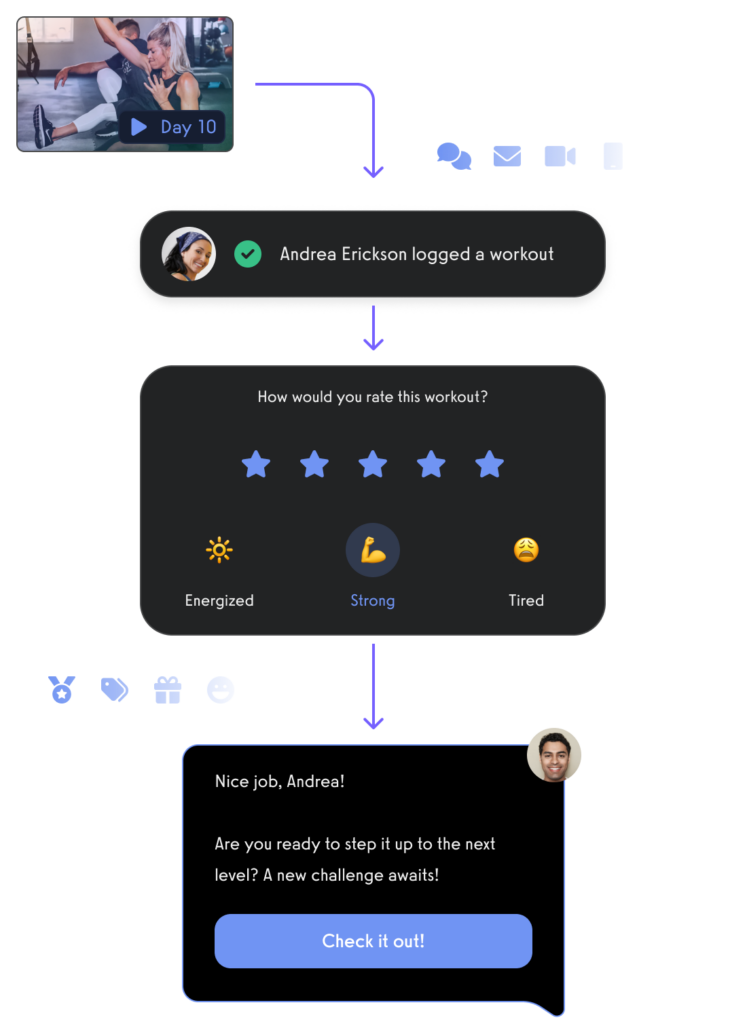
Manage leads with a fitness CRM. Read More: Compare Top Online Gym CRMs
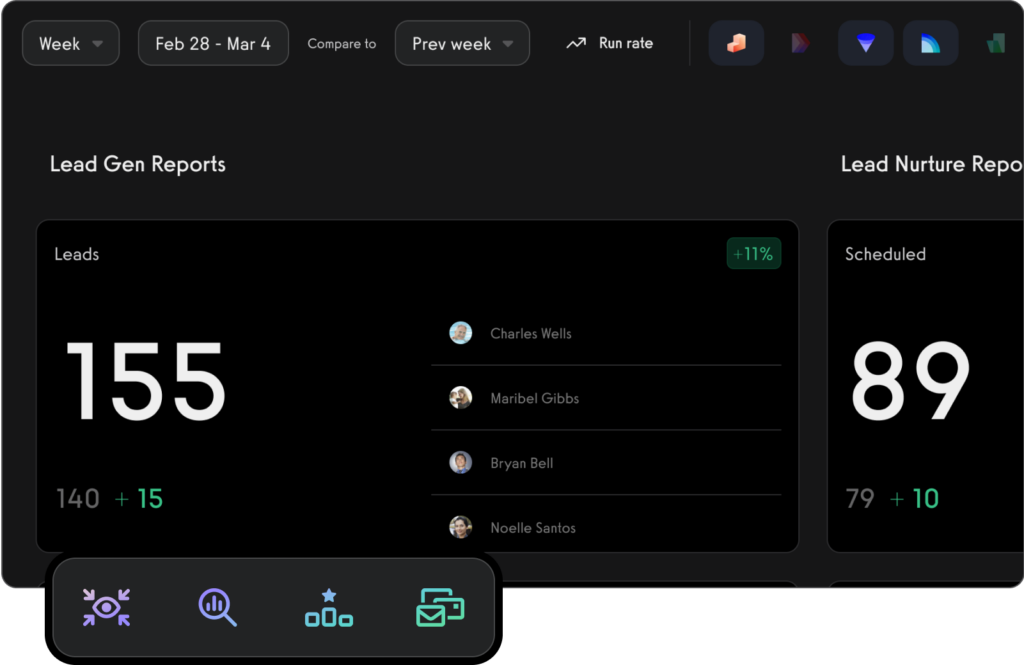
Create and send fitness assessments with ease.
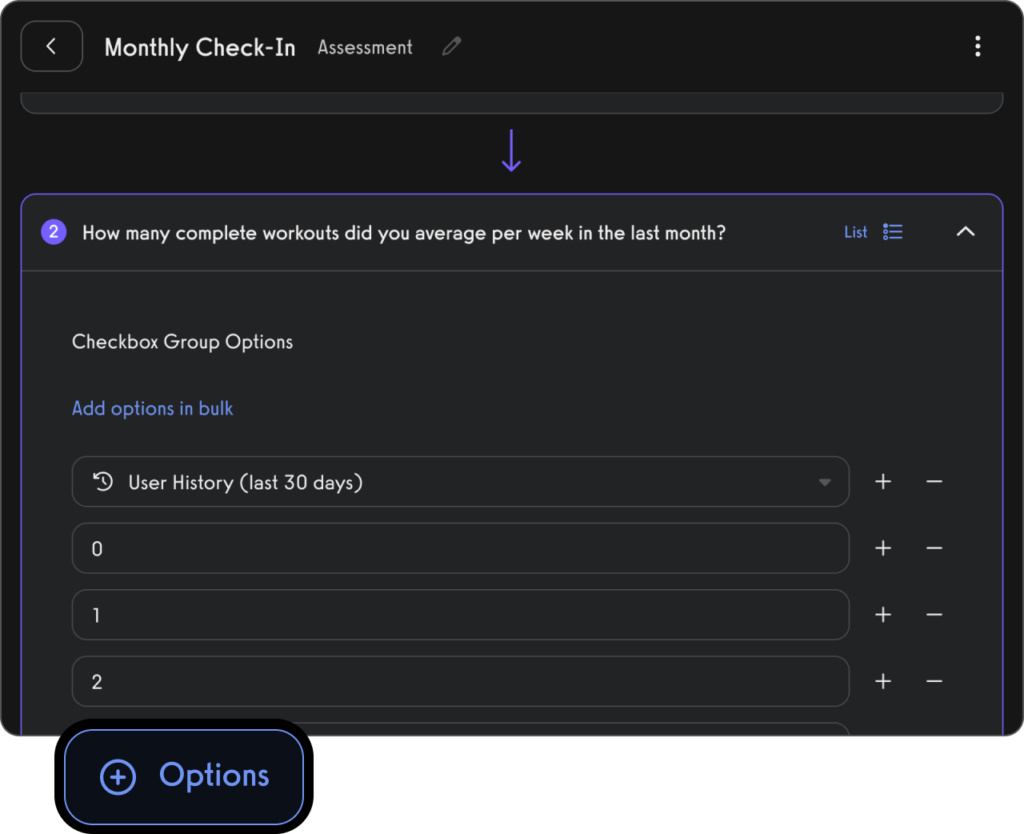
Use fitness habit tracking to inspire and motivate personal training clients (in-person and remote).

Use fitness progress photos to engage with clients.
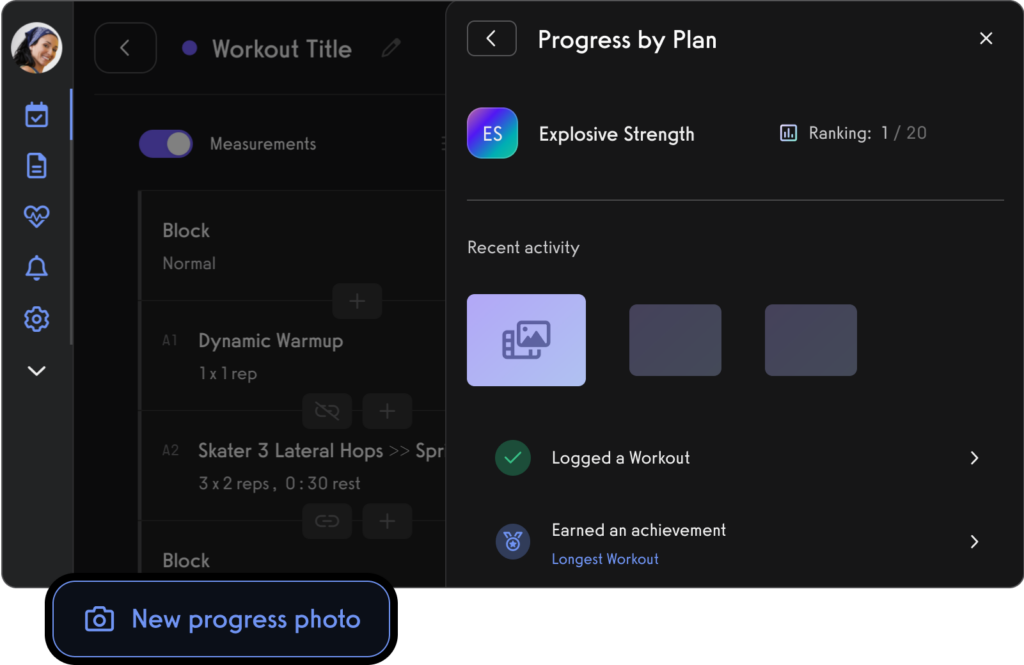
Use fitness leaderboards to track performance and inspire healthy competition.
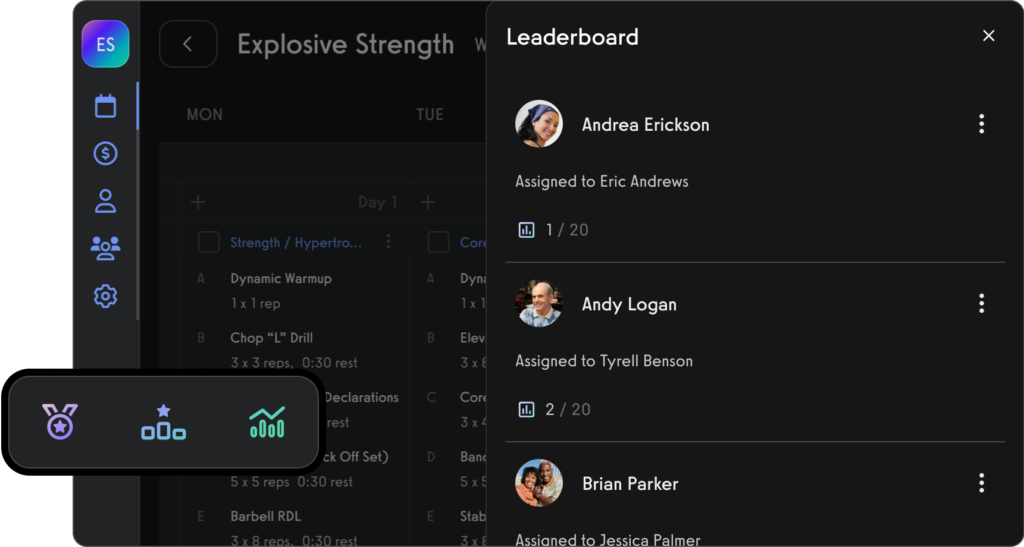
Use the exercise demonstration video library or create your own custom exercise demonstration videos.
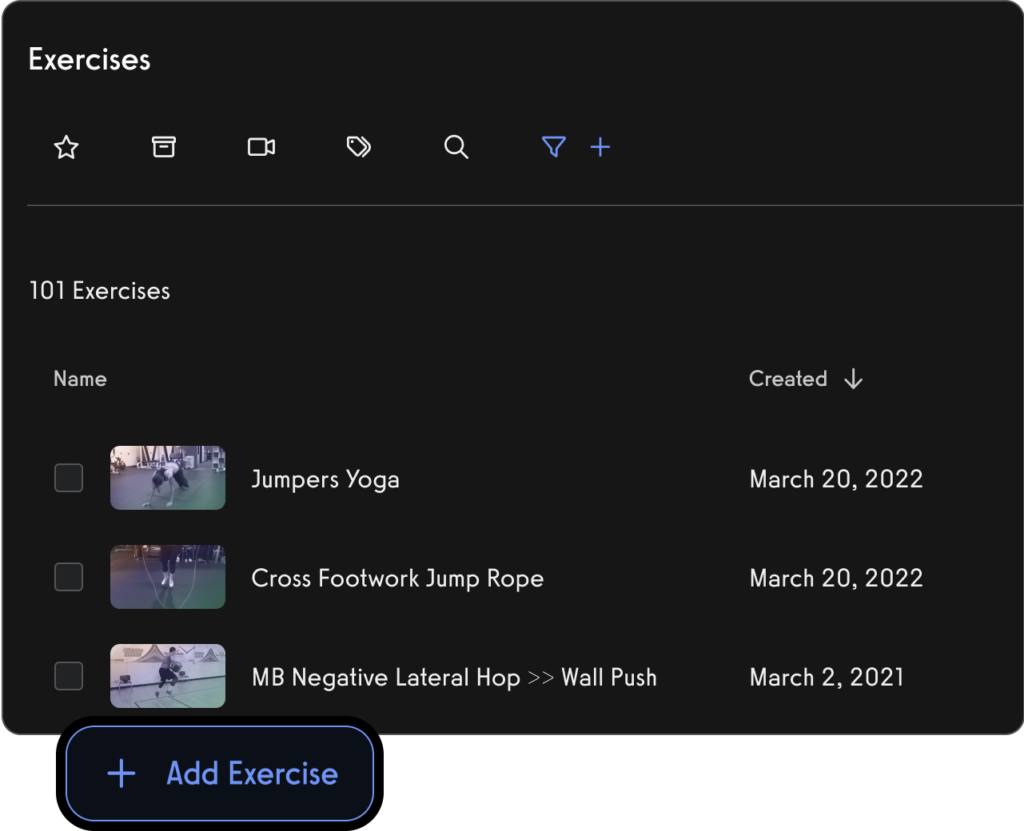
Create workout plans for parents and dependents, teams and more.

Manage personal training clients with ease.
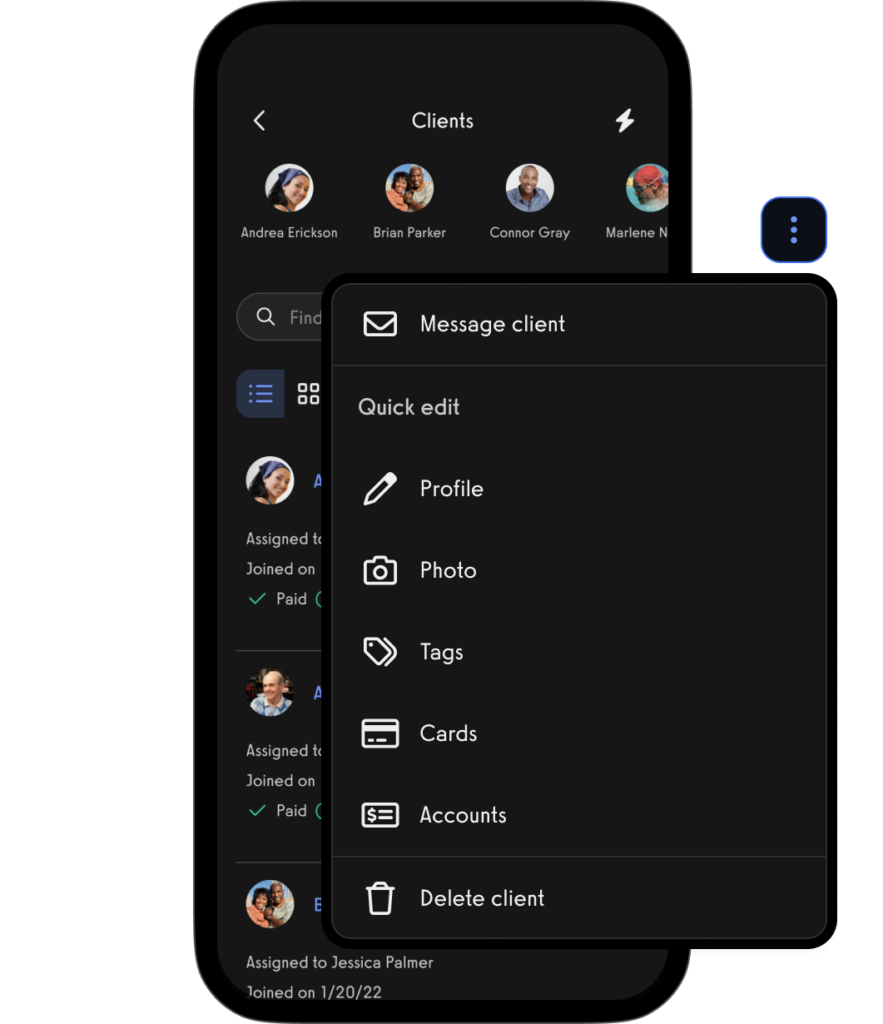
Book appointments for clients (Read More: Best Gym Booking Software)

Create classes and fitness groups

Manage fitness challenges (Read More: 100+ Fitness Challenge Ideas)
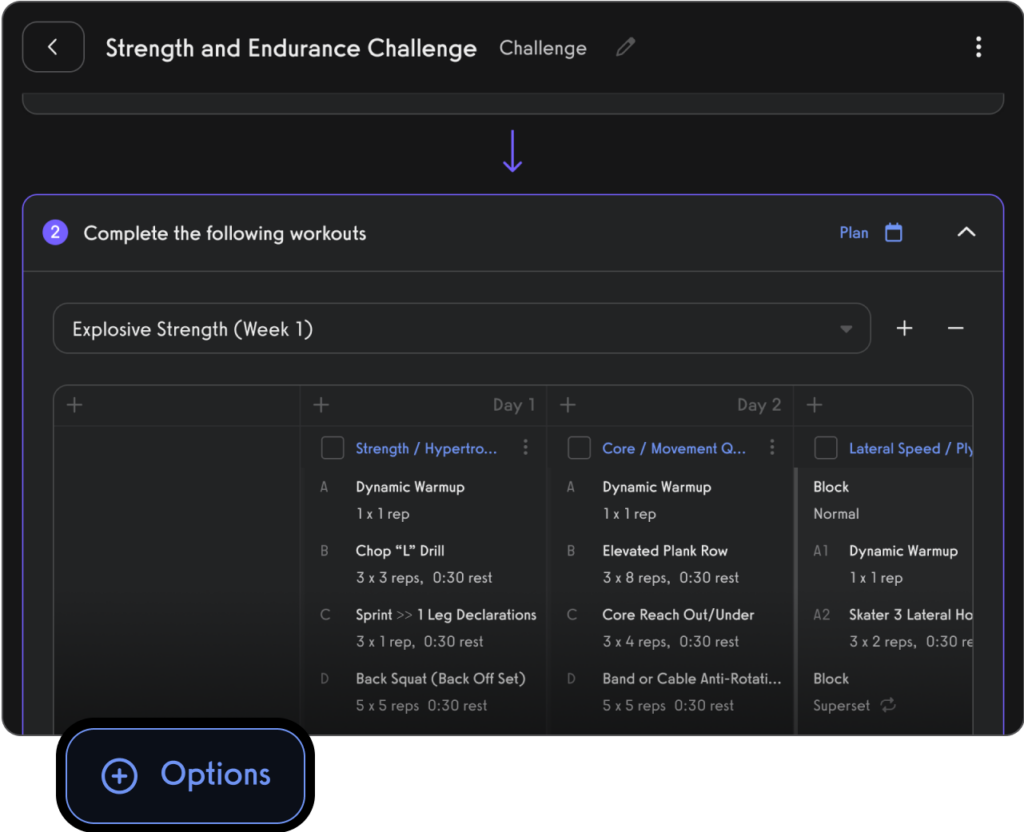
Process payments for open gym, classes, and personal training.

Communicate with gym members, athletes, team members, personal training clients, class members, parents, and dependents via SMS, email, and in-app push notification.
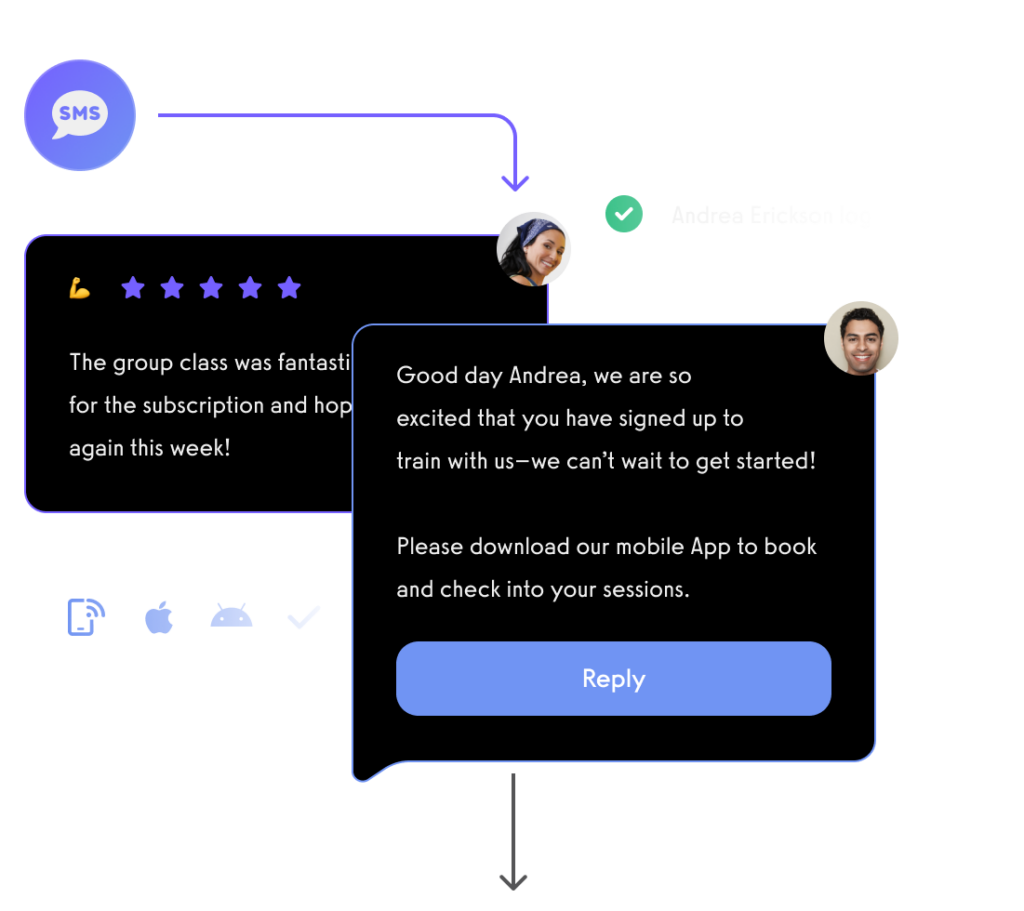
View performance over time, track personal records, and other fitness stats with performance reporting dashboards.

And of course, view all of your fitness business reports easily too.
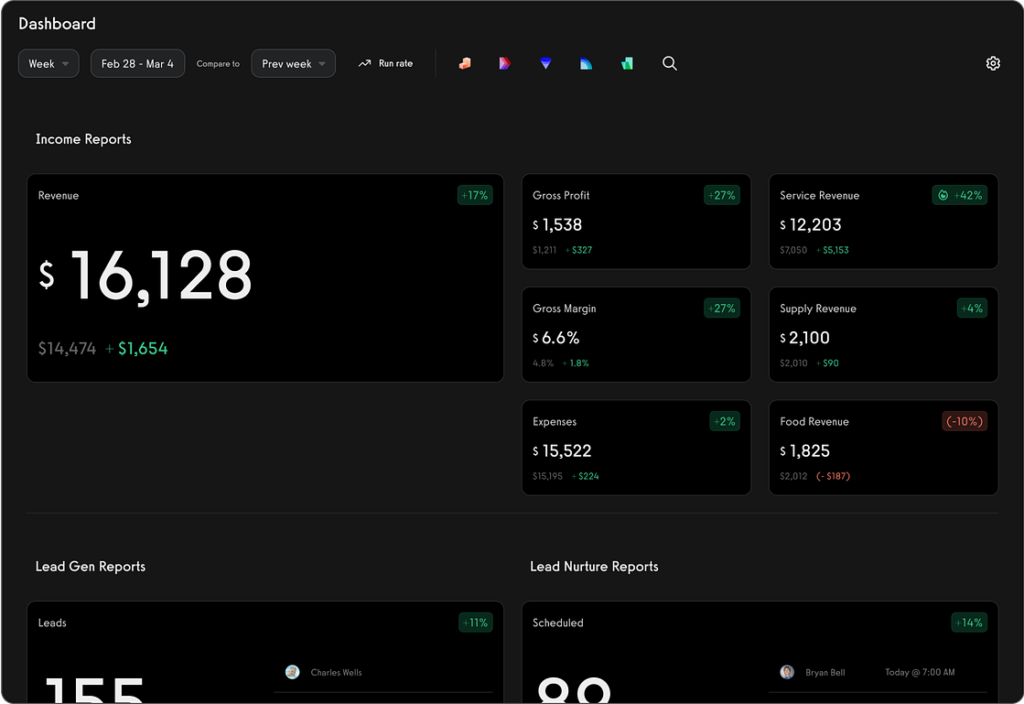
All from your custom-branded fitness apps (Read More: Best Gym Mobile Fitness Apps Software)

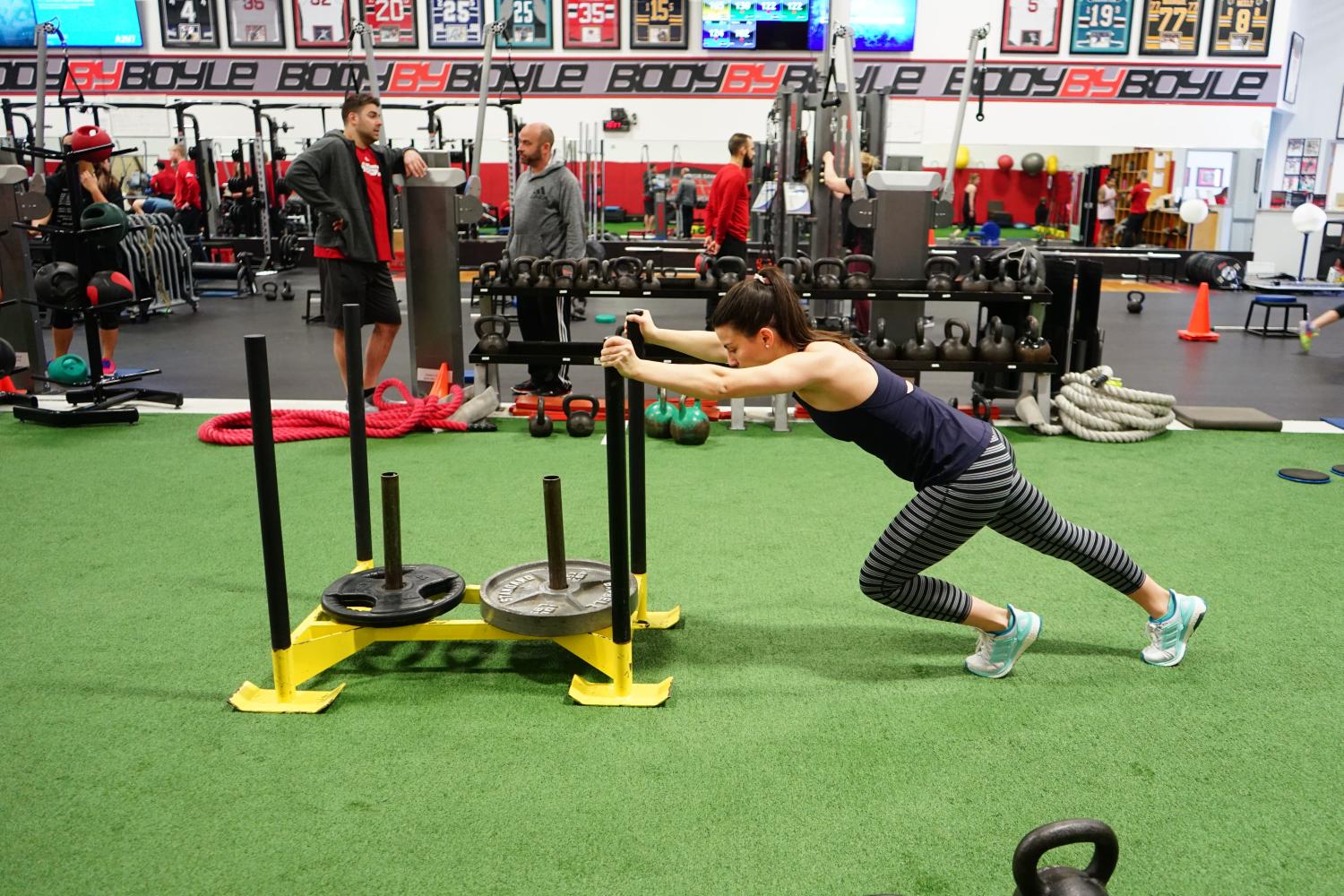
Want to learn how your fitness business can take it to the next level? Get a demo now!









